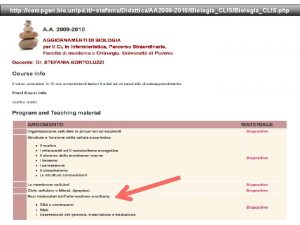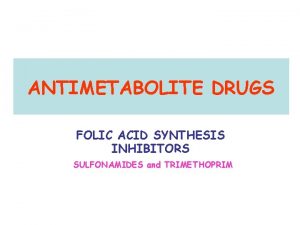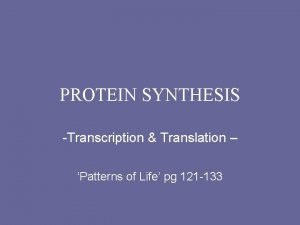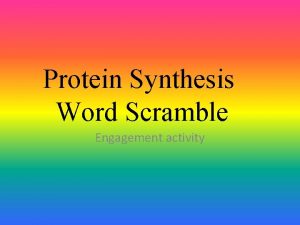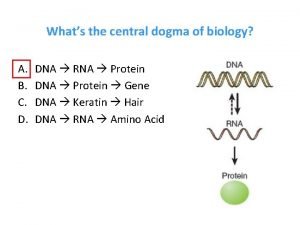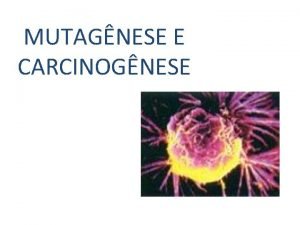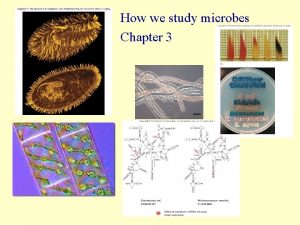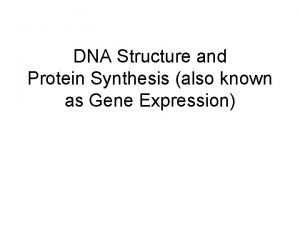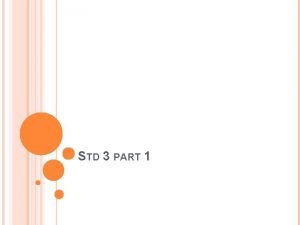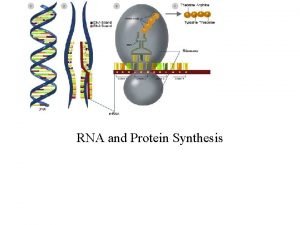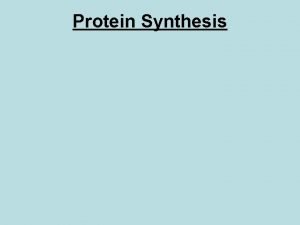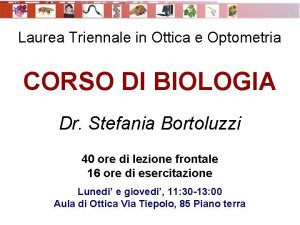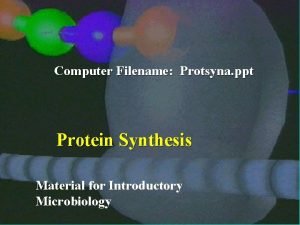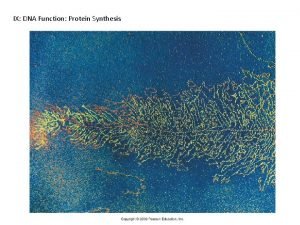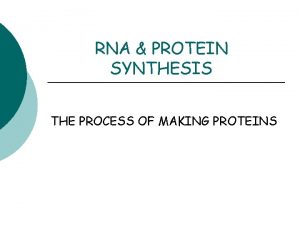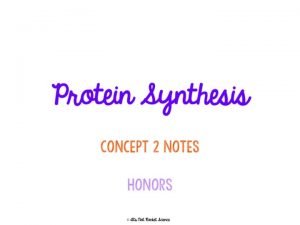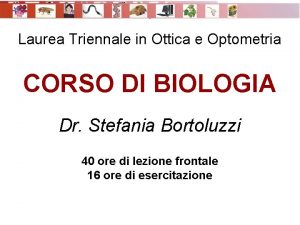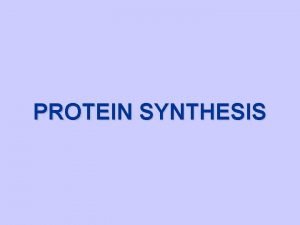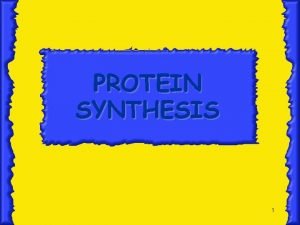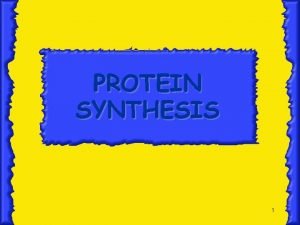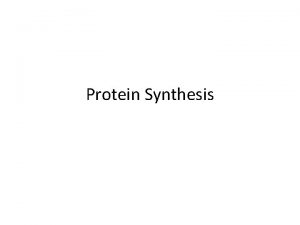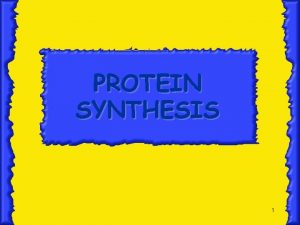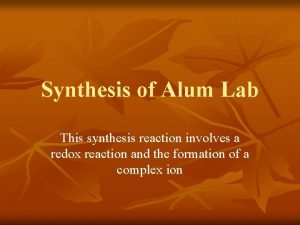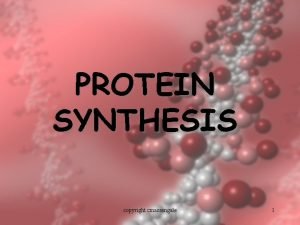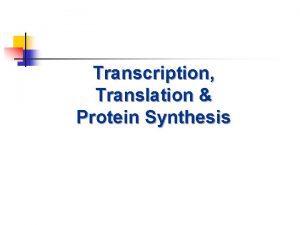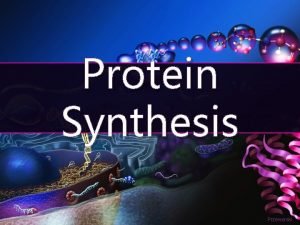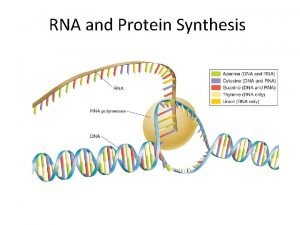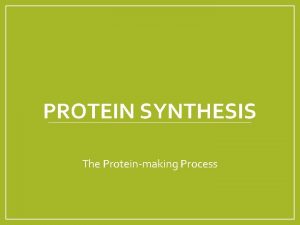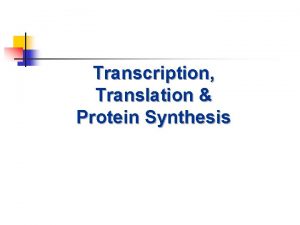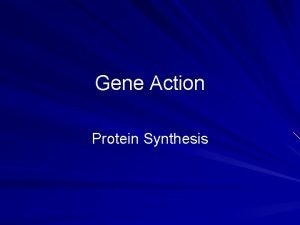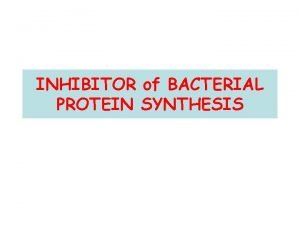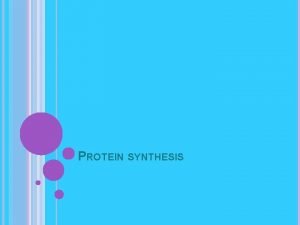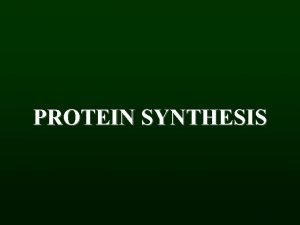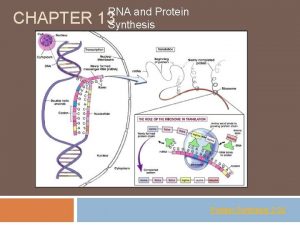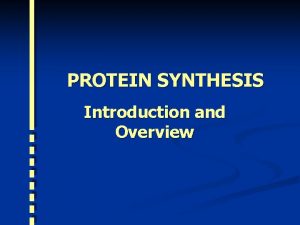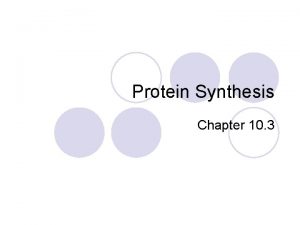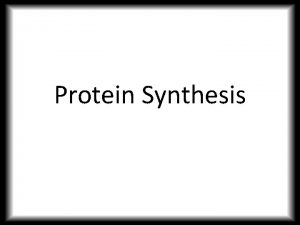Protein Synthesis PROTEIN SYNTHESIS n Protein synthesis involves





























- Slides: 29

Protein Synthesis

PROTEIN SYNTHESIS

n Protein synthesis involves two types of nucleic acids: DNA (deoxyribonucleic acid) RNA (ribonucleic acid)

Differences Between DNA and RNA DNA double-stranded RNA single-stranded sugar = deoxyribose sugar = ribose bases = A, T, C, G bases = A, U, C, G (uracil takes the place of thymine)

RNA n RNA, like DNA, is a polymer formed by a sequence of nucleotides


Free Nucleotide

Protein Synthesis involves two processes: 1. Transcription: the copying of the genetic instructions (DNA) into a molecule of m. RNA 2. Translation: m. RNA is used to assemble an amino acid sequence into a polypeptide (protein)

Pathway to Making a Protein DNA Transcription m. RNA Translation Protein

Transcription n Process in which genetic instructions are transcribed (rewritten) to form an RNA molecule. n occurs in the nucleus of eukaryotic cells n Transcription occurs in 3 major steps:

Step 1: n RNA polymerase (enzyme) binds to the promoter. – Promoter – a specific nucleotide sequence of DNA that initiates transcription. (“START” sequence) n DNA strand unwinds and separates

Step 2: n RNA polymerase adds free RNA nucleotides that are complementary to the nucleotides on one of the DNA strands.

Complementary Pairings: EXAMPLE: DNA RNA A = U T = A C = G G = C A = U C = G

Step 3: n RNA polymerase reaches the “termination signal” sequence of nucleotides that marks the end of transcription. n RNA polymerase releases both the DNA strand the newly formed RNA strand.

n The RNA made during transcription can be any of the three types of RNA: 1. messenger RNA (m. RNA) 2. transfer RNA (t. RNA) 3. ribosomal RNA (r. RNA)

Transcription Animation

Translation (Protein Synthesis) RNA protein

Translation n occurs in the cytoplasm of the cell, at the ribosome n All RNAs needed in translation – m. RNA, t. RNA, and r. RNA

Messenger RNA (m. RNA) n Carries coded instructions for protein synthesis (translation) – From the DNA in the nucleus to the ribosome

The genetic code n Codons – instructions for making a protein, a series of three nucleotides on the m. RNA – Each codon signifies start, stop, or an amino acid

The genetic code

Transfer RNA (t. RNA) n Brings amino acids to the ribosome so it can build proteins n It has Anticodons – 3 nucleotide sequence complementary to the m. RNA codon

Ribosomal RNA (r. RNA) n Makes up ribosomes

Translation Step 1: n m. RNA from nucleus Through cytoplasm to the ribosome m. RNA start codon AUG signals beginning of protein

Translation Step 2: n t. RNA with the complementary anticodon carries amino acid (a. a. ) to bind to the codon

Translation Step 3: n Enzymes help form peptide bonds between amino acids Peptide bond

Translation Step 4: n This continues until a stop codon is reached n Protein is released into the cell

Translation Animation

 Protein synthesis
Protein synthesis Protein synthesis
Protein synthesis Sulfonamides mechanism of action
Sulfonamides mechanism of action Protein synthesis splicing
Protein synthesis splicing Protein synthesis animation mcgraw hill
Protein synthesis animation mcgraw hill Dna rna protein synthesis homework #2 dna replication
Dna rna protein synthesis homework #2 dna replication Protein synthesis scramble
Protein synthesis scramble Whats translation in biology
Whats translation in biology Protein synthesis
Protein synthesis Protein synthesis
Protein synthesis Section 12-3 rna and protein synthesis answer key
Section 12-3 rna and protein synthesis answer key Protein synthesis and mutations
Protein synthesis and mutations Double stranded dna
Double stranded dna Protein synthesis bbc bitesize
Protein synthesis bbc bitesize Which best summarizes the process of protein synthesis?
Which best summarizes the process of protein synthesis? Molecular genetics
Molecular genetics Section 12 3 rna and protein synthesis
Section 12 3 rna and protein synthesis Protein synthesis steps
Protein synthesis steps Protein synthesis
Protein synthesis Protein synthesis
Protein synthesis Protein synthesis ppt
Protein synthesis ppt Messenger rna codons
Messenger rna codons Dna rna and protein synthesis study guide
Dna rna and protein synthesis study guide Catalytic functions
Catalytic functions 4 steps of protein synthesis
4 steps of protein synthesis Concept map of protein synthesis
Concept map of protein synthesis Translate
Translate Cytosio
Cytosio Protein synthesis
Protein synthesis Protein synthesis
Protein synthesis
